Asus ZenBook UX310UA Review
Asus ZenBook UX310UA
Heartbroken by the abandoned MacBook Air? Look no further
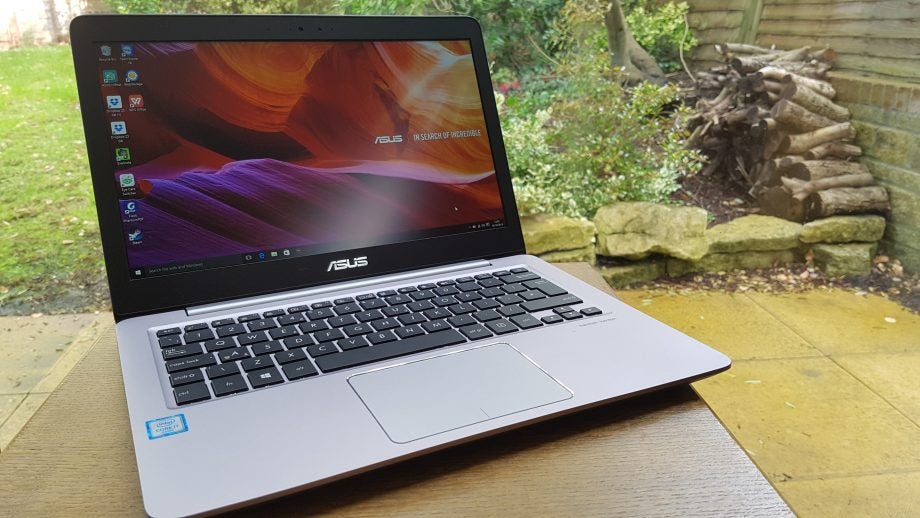
Sections
- Page 1 Asus ZenBook UX310UA Review
- Page 2 Performance, battery life, conclusion Review
Verdict
Pros
- Thin and light design
- Good performance
- SSD/hard disk combination
- Very low starting price
Cons
- Mediocre battery life
- No Intel Iris Graphics
- Less attractive and heavier than rivals
Key Specifications
- Review Price: £800.00
- 2.5-3.1GHz dual-core Intel Core i7-6500U with Hyper-Threading
- 256GB SSD and 500GB hard disk
- 8GB DDR4 RAM
- 13.3-inch 3,200x1,800-pixel screen
- 1.45kg
- Windows 10
- Backlit keyboard
- 1x USB 3.0, 2x USB 2.0, 1x USB 3.1 Type-C, 3.5mm headset, 1x HDMI
- 802.11ac Wi-Fi and Bluetooth 4.1
- Base model starts at £500
What is the Asus ZenBook UX310UA?
The Asus ZenBook UX310UA is a premium and stylish 13.3-inch Ultrabook that doesn’t break the bank. With a starting price of just £550, this mid-range laptop comes with high-end features. These include a beautiful, thin and light metal-coated body, Intel Skylake processors, solid-state storage, a USB Type-C port and a backlit keyboard.
Navigating Asus’ confusing naming conventions isn’t easy: the new UX310UA is the direct successor to the UX303UA (we gave this laptop a 4/5 back in February 2016). There isn’t a whole lot new here, and it isn’t perfect, but for the money the Asus ZenBook UX310UA is one of the most tempting laptops I’ve reviewed in quite some time.
Its £800 price tag puts it in the same territory as the Lenovo IdeaPad 710S Trusted reviewed earlier this year, although the two offer slightly different experiences.
With the MacBook Air seemingly abandoned by Apple, the Windows Ultrabook market is starting to look more promising than ever.
Related: Best laptops to buy
Asus ZenBook UX310UA – Buying Information
With a retail price of £799.99, my review model is the top-spec UX310UA featuring a i7-6500U dual-core processor, 8GB of RAM, a 256GB SSD, 500GB secondary hard drive and a QHD+ resolution display. Considering the Dell XPS 13 costs £100 more for the base i5 Full HD model, I’m really impressed with what you get for your money.
If you’re on a tighter budget, the entry-level UX310UA sports an i3-6100U processor, 4GB of RAM, a 128GB SSD and a Full HD display.
Related: Intel Core i3, i5 and i7 explained
Here it’s worth comparing the specifications of the top-end Lenovo IdeaPad 710S: For the same money you get a larger and faster 256GB SSD, better integrated graphics and a slightly faster Core i7-6560U processor. The IdeaPad is also slightly lighter, but only gets a Full HD screen.
Watch: Trusted explains how to choose a laptop
Asus ZenBook UX310UA – Design and Build
There’s no fancy touchscreen or 360-degree hinge here – this is a traditional clamshell laptop. 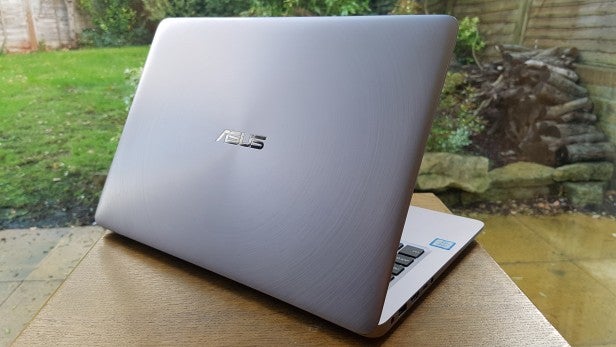
The UX301UA’s all-aluminium coating looks as premium as it feels. Weighing 1.45kg – that’s 550g lighter than the MacBook Pro 13 – and only 18mm thick, this is the ideal travel companion.
Asus’ famous spun-metal finish on the lid looks great, catching the light as you open it. If you’re not a fan of the grey colour on review, the ZenBook is available in bronze and grey metal too.
On the whole build quality is great, screen wobble is minimal, there’s very little flex in the metal body, and the keyboard depresses only slightly with a firm push.
If I have one complaint, it’s that the chunky bezels detract from the high-end aesthetic of the laptop. Next to a Dell XPS 13 and its “infinity-edge” bezels, the UX310UA looks a little dated. It’s a minor gripe but something I’d like to see addressed on future models.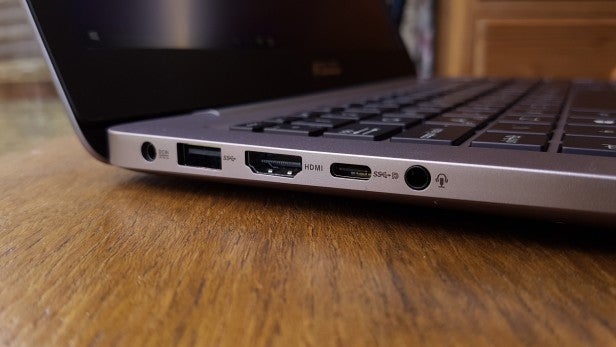
As for ports, the UX310UA offers a peculiar combination of old and new. There are three USB ports, but only one of them is the faster USB 3.0 type. It’s odd to see two USB 2.0 ports on a 2016 laptop – although it isn’t much of an issue if you just use these to plug in mice, keyboards or other peripherals.
The good news is the UX310UA does offer one of the latest reversible USB 3.1 (Type-C) ports, which is a nice piece of future-proofing. Elsewhere there’s a full-size HDMI port, headphone and microphone combo port, card reader and DC power port. It’s hard to think of anything that’s missing here.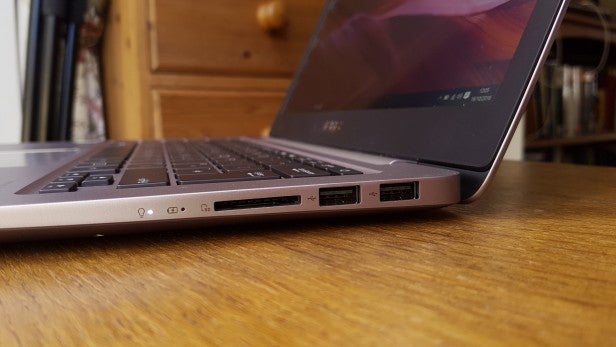
Asus ZenBook UX310UA – Keyboard and Touchpad
The full-sized chiclet-style keyboard on the UX310UA is above average. While the keys do feel a little spongier than I‘d like, they offer a good amount of travel; I was comfortable typing on the keyboard within seconds of using it for the first time. It’s fully backlit, too – a feature the UX303 lacked – which not only adds to the laptop’s premium aesthetic but makes it easier to use in the dark.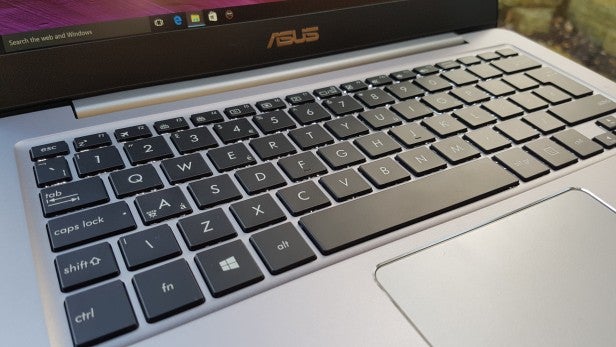
There’s a hint of flex in the keyboard if you press firmly toward the back-middle of the keyboard, but it isn’t something you’ll notice with normal use.
The big, glass trackpad feels great. The smooth surface has two built-in buttons integrated into the bottom of the trackpad. I found it slightly less responsive than I’d like out of the box, but increasing the cursor sensitivity by a notch in Windows easily resolved the issue.
Asus ZenBook UX310UA – Screen
You have the choice of Full HD (1,920 x 1,080) or 3,200 x 1,800-pixel display, depending on which model of the UX310UA you go for.
My review model sports the higher-resolution QHD+ panel, which looks terrific – but I’m not convinced that anyone needs it on a 13.3-inch laptop. You’ll definitely need to make use of Windows scaling (which actually works well in Windows 10) to make the text and icons comfortably usable.
While I appreciate the sharpness (276ppi), unless you put the screen right up to your eye it isn’t something you’ll ever notice. I also believe it has a significant impact on battery life, but we’ll talk more about that later.
What I do like is the IPS panel, which is bright and offers wide viewing angles. Whether you’re watching a Netflix movie, YouTube video or just browsing the web, the display is nice to look at. Asus’ quoted 500:1 contrast ratio is lower than average, and means blacks are less inky and whites are a tad duller than you might expect given the type of panel used. For the price, though, the screen is adequate.
On the plus side, the solid 375cd/m2 maximum brightness combined with the matte panel makes it easy to use the UX310UA when you’re out and about. I found the display remained readable even in direct sunlight (hard to find during the Autumn in the UK).
How we test laptops
Unlike other sites, we test every laptop we review thoroughly over an extended period of time. We use industry standard tests to compare features properly. We’ll always tell you what we find. We never, ever, accept money to review a product.

